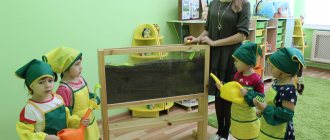Tags: Speech therapy, Speech development
Developing coherent speech in a child: games and other methods
Growing up, a child learns to speak, he learns new words and the rules for their use in phrases and sentences. But in speech education, parents often miss such a moment as the development of coherent speech in their own child, paying more attention to the formation of memorization skills, logical thinking, perseverance, discipline, creative potential, etc. This is done from the banal consideration that children, listening to the speech of adults, skillfully imitate them, which means that over time they will be able to independently build logically correct, coherent speech. However, it is not. Children need to be helped to correctly express their own thoughts by establishing logical connections in their speech. We’ll tell you how to do this further.
general information
In order for a person to be understood, he must speak coherently. This term refers to the correct formatting of a statement. It must meet several criteria:
- logic;
- stylistics;
- psychological coloring;
- grammar of the language.
Only when each point is fulfilled will the speech be correct. The child must speak clearly, meaningfully, accurately and convincingly. The development of coherent speech is the task of not only the preschool institution (DOU), but also the parents.
Various methods and techniques are used for stimulation. Children are taught to correctly compose stories, describe objects and talk about everyday topics.
Experts distinguish two types of coherent speech – dialogic and monologue. The first is characterized by the participation of two or more persons. It is accompanied by intonations, facial expressions, and gestures. Phrases are spoken alternately.
Monologue speech is more complex than dialogic speech. It is long-term, sequentially constructed, where events flow from one another.
Contextual and situational speech are distinguished separately. The first is complex in that it relies only on linguistic means. Situational is simpler, since it is related to a specific situation.
How do retellings affect the development of coherent speech?
If a picture or story meets such requirements as colorfulness, brightness, interestingness, clarity, and not being overloaded with events, objects and other small details, then retelling their plot helps to develop and improve in the child:
- attention;
- memory (visual and auditory);
- logical thinking;
- active vocabulary;
- speech literacy;
- correct speech construction;
- imagination;
- fantasy;
- the ability to notice details and describe them using comparisons and metaphors.
Therefore, it is important to replace the usual retelling with a selective, brief, creative retelling, as well as prediction without relying on visualization.
When assessing the quality of a child’s work, you should rely on:
- completeness of what was said;
- the order of the events presented (are they sequential);
- the use of one’s own, that is, the author’s, phrases and speech patterns, and not those that sounded in the original story;
- correctness of sentence construction;
- the duration of pauses, or rather their absence, which may be associated with the difficulty of selecting the right words/phrases.
Work on developing coherent speech in a preschool child should be consistent and regular. It’s worth starting with the simplest, gradually increasing the load, complicating the tasks. This way, the child will be able to quickly and efficiently replenish his active vocabulary and quickly master literacy, imagery and expressiveness of speech. In practice, the scheme for the development of coherent speech looks like this:
- Initially, the names of objects are learned, dividing them into thematic groups with or without the use of visual aids.
- Then children are taught to select feature words based on the characteristics of objects.
- Children are taught to match verbs to nouns.
- Selection of adverbs for verbs.
- Comparative designs.
- Selection of synonyms.
- Selection of antonyms.
- Formation of new words using prefixes.
By the end of kindergarten, the child’s vocabulary increases significantly and is systematized, becoming meaningful, clear and literate.
Features of development
Before determining developmental delay, you need to understand how coherent speech is formed normally. At the age of four, children develop common sentences, and a little later complex ones.
This period is marked by a large number of questions. The child asks adults about everything in the world. There is a desire to comment, to explain personal actions: I pour out food to feed the birds.
Characteristic skills of children:
- at 4 years old, retelling a fairy tale;
- at 4 years old they memorize poetry;
- At 5 years old they retell short texts.
At four years old, children easily form diminutive forms and new words (iron - iron). After five years, a child can consistently tell a story about what he saw, compose a story, discover cause and effect, and separate a realistic story from a fictional one.
At the age of six, children are able to compose stories and fairy tales independently. The speed and quality of the formation of coherent speech is influenced by parents, educators and other adults who are in close contact with the child.
The development of coherent speech directly depends on thinking.
Folklore shows children the beauty of their native language, its means, intonation techniques, teaches them to act in a certain way, shows cause and effect. Fiction similarly helps in educating a preschooler.
What techniques are used to develop coherent speech?
The formation of coherent speech in preschool children occurs more successfully when using the following basic techniques:
- development of dialogical skills;
- retelling training;
- teaching stories from pictures;
- writing descriptive stories.
During dialogue, children learn to hear and understand the speech of their interlocutor, communicate with peers, answer questions, constructing dialogical speech, repeat words and phrases of different lengths, memorizing them. Preschool children are taught to construct simple monologue forms.
If we talk about retellings, then this method of developing speech coherence is a little more complicated than dialogue, since such classes require perseverance, attentiveness, and concentration from the child. The work begins with preparing for the retelling: for this, the adult reads the text, and the child listens to it carefully. Then the adult asks questions about the text, which the preschooler must answer. A story plan is drawn up together, after which the selected material is read to the adults again, after which the child begins to retell it. Preschoolers do almost all the work together with an adult, but older children can complete the task independently.
Pictures greatly facilitate independent retelling and are an indispensable technique for developing coherent speech in children. It’s easier for the child, because he sees the whole plot in the picture. For younger preschoolers, they use pictures depicting simple objects, and they describe them by answering leading questions from an adult.
From the age of four, preschool children learn to create a story from pictures. Preparation for work requires a preliminary examination of the image, answers to an adult’s questions, and listening to an adult’s story. Only after this can the child begin an independent story.
All the time, the adult must control the child’s speech; he can provide supporting words and phrases. By the age of five, children are taught to draw up a plan according to which they will produce a story. At the age of 6-7 years, a child can notice details that are invisible at first glance, describe the landscape or events in the background of the picture. At this age, a preschooler should be able to look at an image and tell what happened before and after the events shown. In this way, the preschooler builds his own storyline, and the adult must help him with this. The adult’s task is to monitor the literacy of speech, the correct construction of sentences, the sequence of thoughts expressed, and the richness of the vocabulary. It is most useful to pay attention to paintings depicting landscapes, where children are required to use words in a figurative sense, antonyms and synonyms, and comparisons.
Descriptive stories also help develop coherent speech. First, children are taught to describe toys and various objects. Then, with age, the task becomes more complicated, and the child is asked to describe a situation or time of year. As the child grows up, he is asked to make a comparative description of several objects or living objects with similar or different characteristics.
Another quite interesting technique is mnemonics. To carry it out, all works of art intended for retelling are encoded with pictures: for example, if they talk about domestic animals, then a house is drawn next to them, if they talk about vegetables growing in the garden, trees are drawn, etc. The main thing is that these codes resemble speech material as closely as possible.
Examination methods
Before starting correctional work, the speech therapist conducts diagnostics. It can be done in a kindergarten, provided that a specialist is on staff.
If you suspect that your child has problems, you can show him to a speech therapist at the clinic.
At the first stage, a word is called and what it is is explained: a chair is a board on four legs, people sit on it. After which they list a number of words and ask them to explain their meaning (TV, telephone, store).
To determine the completeness of vocabulary, different games are used. They show pictures of people of different professions and ask them to say who they are. The game “What the artist forgot to depict” is in demand, where each drawing does not have a certain detail.
The game “Say it the other way around” helps to understand how well a child feels the language. During it, it is asked to name antonyms: hot - cold, sharp - dull, low - high.
To correctly assess development, only those words that children use are taken into account. Each group has its own set, compiled taking into account the age norm.
In this part, mastery of verbs, adjectives, gender concepts and other points is assessed. The tasks should become more difficult as you progress.
A simple way to assess understanding of instructions is to ask them to do something. Draw a square, color a circle and others.
Children are asked to complete a task with the formation of new words (endearments, signs). The understanding and use of simple and complex prepositions are carefully checked.
In the process of communication, the speech therapist notes the ability to independently construct a statement, put words into singular and plural. At the age of five, children are asked to compose a story based on pictures.
Levels of speech coherence
It is necessary to conduct an examination to determine the level of coherent speech in an environment familiar to the child. This will prevent distraction. The teacher or speech therapist must also have prior experience communicating with a particular child.
It is better to use didactic material or ask questions based on the preschooler’s personal experience. Provide additional motivation if necessary.
Use a picture with a simple plot or a toy with an object in your hands (for example, a doll with flowers).
Be sure to encourage your child to tell a story. “The doll was going to visit and bought flowers for the hostess. Do you think she will like the flowers? What will the doll be treated to?”
It is better for an adult not to ask questions, but to tell his story and suggest connecting words to the child. It may take more than one conversation.
In modern speech therapy, there are 4 levels.
- Level I - high. The child's stories are well written. The descriptions are detailed, the characteristics of the object of the story are given attributes, the child uses simple means of expression (comparisons, definitions). Thoughts are connected to each other using pronouns, lexical repetition, and synonyms. Statements have a logical structure and sequence, contain description and direct speech.
- Level II – sufficient. Descriptions consist of two parts. The main part of the topics is not fully revealed, but there is a connection between the thoughts. The stories may omit any description or characterization, but the main idea is clearly stated. In the story, events develop mainly sequentially, there is a logical chain.
- Level III - intermediate. All characteristics are incomplete. There are secondary themes, but they are not fully explored. Means of expression are rarely used. The connection in the text is formal and does not have a clear structure. In the main part, the sequence of actions and connections is broken. There are practically no synonyms and pronouns.
- Level IV - low. A story based on a descriptive picture. The parts of the object are simply listed, no verbs or adjectives are used. The child carefully selects words to characterize the object and action.
Be sure to take into account the volume of the story, the use of filler words, and the presence of intonation pauses.
Causes of problems
Problems with the formation of coherent speech arise with alalia, delayed speech development. With such diagnoses, there is a significant delay in the formation of speech components.
In severe cases, not only sound pronunciation suffers, but also vocabulary, grammar, syntax, and syllable structure. Children have a hard time forming words and choosing synonyms and antonyms.
Problems are also noted with other developmental problems. With intellectual disabilities, deafness and insufficient vision, the primary defect will not be a problem with speech, but an organic lesion of the central nervous system. Building the right structure affects the construction of correctional assistance.
Speech problems appear due to various factors:
- hypoxia and asphyxia during childbirth;
- illnesses of the father and mother;
- heredity.
In recent years, social reasons have also been identified. Passion for gadgets and TV deprives children of the most important thing - communication with adults. Parents find it unpleasant to answer questions; they do not play with the child. He has nowhere to get material for the formation of speech.
Important Principles
Experts have developed a method for developing coherent speech in preschool children. It is designed for children aged 5-7 years. It is based on certain principles that are strictly followed.
The basis of everything is early exposure. The longer the defect lasts, the longer it will take to correct. Speech problems will lead to secondary disorders.
When drawing up a training program, they rely on the ontogenesis of speech development. All components of speech are interconnected: speech hearing is the basis for word formation. Therefore, they are developing each of them.
It is necessary to understand the structure of the defect and provide an individual approach. The program lasts two years, and it allows you to master:
- grammar;
- phonetics;
- elements of literacy.
It is most effective to work in a specialized kindergarten. In it, the child will be in a small group; a teacher, psychologist and other specialists will conduct classes with him.
Without corrective assistance, children will have difficulty mastering writing and reading. The development of secondary intellectual disabilities is possible.
How does a child develop coherent speech?
When working on speech coherence, follow the following sequence in classes:
- work on understanding coherent speech;
- develop dialogical coherent speech;
- develop monologue coherent speech.
For the process of developing speech coherence, various methods are used that are aimed not only at logically correct presentation of one’s thoughts, but also at replenishing the vocabulary. The main means are fairy tales and other literature, didactic games, theatrical performances. It is important that the activities are appropriate for the child’s age. In this case, either one type of activity or several can be used.
The formation of coherent speech in preschool children goes through several stages.
- Age from birth to one year. In infancy, the baby becomes familiar with sounds. In the first weeks after birth, the baby listens to the speech of loved ones, while he develops a passive vocabulary of sounds. For the first time, the baby lets out screams and grunts. After some time, babbling of random sounds appears. During this period, it is important to work with the child: show different objects, tell what sounds they make (for example, a clock - tick-tock, a car - br-rr, a cow - moo-oo), pronounce their names, describe their characteristics . Over time, the newborn will begin to respond to the names of familiar objects and will look for them. With normal development, by the age of one year the baby begins to pronounce individual syllables, simple words, such as “mom”, “dad”, “lala”, etc.
- Preschool stage, age 1-3 years. The baby’s speech contains simple words, which he most often uses to designate objects, actions, desires (for example, the word “give” - his child says when he asks for a toy, wants to eat, wants to get dressed, so only close people can understand him). After some time, the baby begins to pronounce simple sentences, now he can express his thoughts more accurately. By the end of this age period, the child uses prepositions in his speech and coordinates words by case and gender.
- Preschool stage, age 3-7 years. At this age, the child’s consciousness is formed, he becomes a full-fledged personality, and understands this. By the end of this age period, the child develops correct, clear, meaningful speech, his speech apparatus is already fully formed. The preschooler competently constructs complex sentences, and his vocabulary is constantly updated with new words.
- School stage, age 7-17 years. The main difference in speech development at this age is its conscious assimilation. Schoolchildren master sound analysis, grammatical rules by which it is customary to construct statements. Written speech develops and improves.
There are no clear boundaries between the stages described. Each of them gradually flows into the next and depends on the general mental and psycho-physical development of the child.
Sample tasks
There are ready-made manuals on lexical topics (authored by Arbekova or Teremkova). Speech therapists use independently developed games.
Modeling among children is gaining popularity. It is based on the material already studied and consists of several stages.
To easily master the skill of storytelling, use ready-made symbols. Preschoolers are told a fairy tale, then have a conversation about it, analyzing the main points. Next, each character is associated with a specific geometric figure (for example, a black cat is a black triangle). Children are asked to retell the text using geometric shapes.
For the initial stage, simple stories are used. Gradually increase the difficulty.
Mnemonics allows you to memorize poems. To do this, make a small schematic picture for each word. When a child learns a text, it will be easier for him to rely on the symbols he sees.
During the learning process, children must master certain components of speech. Prepositions are easier to learn using visual material. You will need a small box and a tiny machine. The toy is placed in different places, its location being announced:
- on the box;
- in the box;
- under the box.
With these props, verbs are mastered: the car arrived, drove in, left, drove around, etc. The child himself carries out the actions - this forms a connection between word and deed.
In each lexical topic, different tasks are distinguished - this is the selection of antonyms, diminutive forms, features. In case of difficulties, the child is gently corrected.
A plan for correcting the pronunciation of sounds must be formed. Work is underway to develop vocabulary and grammar.
Teaching preschoolers retelling
Retelling is an excellent way to develop the skill of coherent monologue speech and consists in the fact that a preschooler reproduces the content of a text heard earlier.
You can expand the task by inviting the child to come up with some details, for example, to describe the hero, or to continue the actions of the hero.
In order for the retelling to be accurate and competent, it is necessary to analyze the text, its structure and composition. Then I extracted information from the text, memorized it and repeated it as accurately as possible.
The usefulness of this method increases significantly when an adult uses literary texts with original literary speech, vivid descriptions, and numerous techniques and turns of phrase.
Coherent speech gradually becomes more expressive, it contains emotional and figurative phrases.
In order not to lose the thread of the story and not to switch to minor details, the child learns to carefully follow the structure and logical chain of the text.





